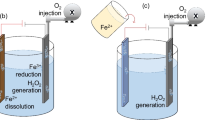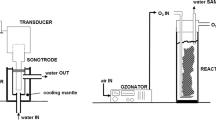Abstract
Advanced oxidation processes (AOPs) and membrane separation processes are successfully used in the final stages of wastewater treatment for recycling and reuse purposes. This research proposes a new two stage process including in the first step a homogeneous Sono-Fenton process (as an AOP), coupled with ultrafiltration (UF), as a cleaner and safer alternative for advanced wastewater treatment, designed specially to enhance the removal of priority organic pollutants which are difficult to eliminate by means of conventional treatments. The aim of this study is to analyze experimentally the performances of an integrated ultrasonication-UF process for the removal of 4-chlorophenol (4CP) (as a model-pollutant for priority organic compounds from wastewaters), both from the removal efficiency (expressed as phenolic concentration and chemical oxygen demand reduction) and the energy consumption point of view. The most important factors with influence on both stages of the proposed process, such as acoustic amplitude, power density, and operating mode for the Sono-Fenton process and pressure, time, operating mode, and cleaning operations for the UF stage, were assessed in this paper (Part 1). The experimental results indicate that the process can be applied for such aqueous effluents, in laboratory scale equipments and represent the basis for modeling the process steps and scale-up of different process arrangements (Cailean et al. (2014): “Integrated Sono-Fenton UF Process for 4CP Removal from Aqueous Effluents: Process Modeling and Simulation (Part 2)”), with the purpose to analyze and control such a process, under various conditions and to understand better its advantages and disadvantages.













Similar content being viewed by others
Abbreviations
- A:
-
Acoustic amplitude
- AOPs:
-
Advanced oxidation processes
- 4CP:
-
4-Chlorophenol
- CF:
-
Cross-flow mode
- DE:
-
Dead-end mode
- DW:
-
Direct washing
- J0 :
-
Clean water flux
- Lm :
-
Initial permeability determined with demineralised water
- MWCO:
-
Molecular weight cutoff
- RE:
-
Removal efficiency
- UF:
-
Ultrafiltration process
- US:
-
Homogeneous Sono-Fenton process
References
Ahmad AL, Puasa SW (2007) Reactive dyes decolourization from an aqueous solution by combined coagulation/micellar-enhanced ultrafiltration process. Chem Eng J 132:257–265
Allegre C, Moulin P, Maisseu M, Charbit F (2004) Savings and re-use of salts and water present in dye house effluents. Desalination 162:13–22
Arsene D, Musteret CP, Catrinescu C, Apopei P, Barjoveanu G, Teodosiu C (2011) Combined oxidation and ultrafiltration processes for the removal of priority organic pollutants from wastewater. Environ Eng Manag J 10:1967–1976
Arsene D, Teodosiu C, Barjoveanu G, Apreutesei RE, Apopei P, Musteret CP, Cailean D (2013) Combined catalytic oxidation and adsorption of priority organic pollutants for wastewater recycling. Environ Eng Manag J 12(5):907
Barjoveanu G, Teodosiu C (2009) Priority organic pollutants removal by ultrafiltration for wastewater recycling. Environ Eng Manag J 8:277–287
Bolong N, Ismail AF, Salim MR, Matsuura T (2009) A review of the effects of emerging contaminants in wastewater and options for their removal. Desalination 239:229–246
Cailean D, Teodosiu C (2012) Integrated ultrasonication –ultrafiltration process for the treatment of textile effluents: assessment of operational parameters. Environ Eng Manag J 11:259–270
Cailean D, Wukovits W, Teodosiu C, Ungureanu F, Friedl A (2014) Integrated Sono-Fenton ultrafiltration process for 4-chlorophenol removal from aqueous effluents: process modeling and simulation (part 2). J Clean Techn Environ Policy. doi:10.1007/s10098-014-0716-9
Cassini AS, Tessaro LC, Marczak LDF, Pertile C (2010) Ultrafiltration of wastewater from isolated soy protein production: a comparison of three UF membranes. J Clean Prod 18:260–265
Chen TG, Shen YH, Lee WJ, Lin CC, Wan MW (2010) The study of ultrasound-assisted oxidative desulfurization process applied to the utilization of pyrolysis oil from waste tires. J Clean Prod 18:1850–1858
Chen Y, Liu C, Nie J, Wu S, Wang D (2012) Removal of COD and decolorizing from landfill leachate by Fenton’s reagent advanced oxidation. J Clean Techn Environ Policy. doi:10.1007/s10098-013-0627-1
Chitra S, Paramasivan K, Sinha PK, Lal KB (2004) Ultrasonic treatment of liquid waste containing EDTA. J Clean Prod 12:429–435
Chowdhury P, Viraraghavan T (2009) Sonochemical degradation of chlorinated organic compounds, phenolic compounds and organic dyes—a review. Sci Total Environ 407:2474–2492
Cui Z (2005) Protein separation using ultrafiltration-an example of multi-scale complex systems. China Particuol 3:343–348
de Koning J, Bixio D, Karabelas A, Salgot M, Schafer A (2008) Characterisation and assessment of water treatment technologies for reuse. Desalination 218:92–104
Dorathi PJ, Palanivelu K (2010) Sonochemical degradation of p-chlorophenol in aqueous solution using hypervalent iron. Indian J Chem Technol 17:111–119
ElDefrawy NMH, Shaalan HF (2008) Integrated membrane solutions for green textile industries. Desalination 204:241–254
Ghodbane H, Hamdaoui O (2009) Degradation of acid blue 25 in aqueous media using 1700 kHz ultrasonic irradiation: combination ultrasound/Fe(II) and ultrasound/H2O2. Ultrason Sonochem 16:593–598
Gultekin I, Ince NH (2006) Degradation of aryl-azo-naphthol dyes by ultrasound, ozone and their combination: effect of α-substituents. Ultrason Sonochem 13:208–214
Hamdaoui O, Naffrechoux E (2008) Sonochemical and photosonochemical degradation of 4-chlorophenol in aqueous media. Ultrason Sonochem 15:981–987
Hao H, Wu M, Chen Y, Yin Y, Lu Z (2003) Cavitation-induced pyrolysis of toxic chlorophenol by high frequency ultrasonic irradiation. Wiley Periodicals, Inc. Environ Toxicol 18:413–417
Hochstrat R, Wintgens T, Melin T (2008) Development of integrated water reuse strategies. Desalination 218:208–217
Ince N, Tezcanli G, Belen R, Apikyan I (2001) Ultrasound as a catalyzer of aqueous reaction systems: the state of the art and environmental applications. Appl Cat B-Environ 29:167–176
Jiang Y, Petrier CT, Waite TD (2006) Sonolysis of 4-chlorophenol in aqueous solution: effects of substrate concentration, aqueous temperature and ultrasonic frequency. Ultrason Sonochem 13:415–422
Judd SJ, Jefferson B (2003) Membrane for industrial wastewater recovery and re-use. Elsevier, Amsterdam
Kotowski S (1999) Method and device for staged treatment of organically polluted wastewaters. Patent DE 19806768 A1, Germany
Kylonnen HM, Pirkonen P, Nystrom M (2005) Membrane filtration enhanced by ultrasound: a review. Desalination 181:319–335
Munter R (1998) Ozone and pulp & paper industry. Proc. CST Workshop in Separation Technology, Lappeenranta
Musteret CP, Cailean D, Barjoveanu G, Teodosiu C (2010) An assessment of operational parameters for the removal of chlorophenols from wastewater. Environ Eng Manag J 9:1451–1457
Nalini Vijaya Laxmi P, Saritha P, Rambabu N, Himabindu V, Anjaneyulu Y (2010) Sonochemical degradation of 2-chloro-5 methyl phenol assisted by TiO2 and H2O2. J Haz Mat 174:151–155
Rokhina EV, Repo E, Virkutyte J (2010) Comparative kinetic analysis of silent and ultrasound assisted catalytic wet peroxide oxidation of phenol. Ultrason Sonochem 17:541–546
Segura Y, Molina R, Martinez F, Melero JA (2009) Integrated heterogenuous sono-photo fenton processes for the degradation of phenolic aqueous solutions. Ultrason Sonochem 16:417–424
Sekaran G, Karthikeyan S, Evvie C, Boopathy R, Maharaja P (2013) Oxidation of refractory organics by heterogeneous Fenton to reduce organic load in tannery wastewater. J Clean Techn Environ Policy 15:245–253
Show KY, Mao T, Lee DJ (2007) Optimisation of sludge disruption by sonication. Water Res 41:4741–4747
Sivakumar V, Gayathri K, Pranavi PS, Chandrasekavaran F (2012) Ultrasound assisted cleaner alternate emulsification method for oils and fats: tallow emulsion-fatliquor preparation for leather application. J Clean Prod 37:1–7
Sri Bala Kameswari K, Kalyanaraman C, Thanasekaran K (2011) Effect of ozonation and ultrasonication pretreatment processes on co-digestion of tannery solid wastes. J Clean Techn Environ Policy 13:517–525
Sumita I, Sawada S, Ariga H (1999) Treatment of water containing organic components and manganese. Patent JP 11099387 A2, Japan
Teng MY, Lin SH, Wu CY, Juang RS (2006) Factors affecting selective rejection of proteins within a binary mixture during cross-flow ultrafiltration. J Membr Sci 281:103–110
Teo KC, Xu Y, Yang C (2001) Sonochemical degradation for toxic halogenated organic compounds. Ultrason Sonochem 8:241–246
Tezcanli-Guyer G, Ince NH (2004) Individual and combined effects of ultrasound, ozone and uv irradiation: a case study with textile dyes. Ultrason 42:603–609
Urkiaga A, de las Fuentes L, Bis B, Chiru E, Balasz B, Hernandez F (2008) Development of analysis tools for social, economic and ecological effects of water reuse. Desalination 218:81–91
Vassilakis C, Pantidou A, Psillakis E, Kalogerakis N, Mantzavinos D (2004) Sonolysis of natural phenolic compounds in aqueous solutions: degradation pathways and biodegradability. Water Res 38:3110–3118
Wang L, Zhu L, Luo W, Wu Y, Tang H (2007) Drastically enhanced ultrasonic decolorization of methyl orange by adding CCl4. Ultrason Sonochem 14:253–258
Wang N, Zhu L, Wang M, Wang D, Tang H (2010) Sono-enhanced degradation of dye pollutants with the use of H2O2 activated by Fe3O4 magnetic nanoparticles as peroxidase mimetic. Ultrason Sonochem 17:78–83
Wang W, Yu B, Zhong C (2012) Use of ultrasonic energy in the enzymatic desizing of cotton fabric. J Clean Prod 33:179–182
Wei W, Keh CCK, Chao-Jun L, Varma RS (2004) Water as a rection medium for clean chemical processes. J Clean Techn Environ Policy 6:250–257
Wu J, Eiteman MA, Law SE (1998) Evaluation of membrane filtration and ozonation processes for treatment of reactive-dye wastewater. J Environ Eng ASCE 124:272–277
Zhang H, Zhang J, Zhang C, Liu F, Zhang D (2009) Degradation of C.I. Acid Orange 7 by the advanced fenton process in combination with ultrasonic irradiation. Ultrason Sonochem 16:325–330. http://www.pcimembranes.pl/Tubular-membranes.html
Acknowledgment
This work was supported by the Romanian National Authority for Scientific Research, CNDI–UEFISCDI, Project no. 60/2012 (PNII Parteneriate), “Integrated System for Reducing Environmental and Human-related Impacts and Risks in the Water Use Cycle” (WATUSER) and BRAIN project “Doctoral scholarships as an investment in intelligence” (ID-6681), financed by the European Social Fund and the Romanian Government.
Author information
Authors and Affiliations
Corresponding author
Rights and permissions
About this article
Cite this article
Cailean, D., Teodosiu, C. & Friedl, A. Integrated Sono-Fenton ultrafiltration process for 4-chlorophenol removal from aqueous effluents: assessment of operational parameters (Part 1). Clean Techn Environ Policy 16, 1145–1160 (2014). https://doi.org/10.1007/s10098-014-0723-x
Received:
Accepted:
Published:
Issue Date:
DOI: https://doi.org/10.1007/s10098-014-0723-x




